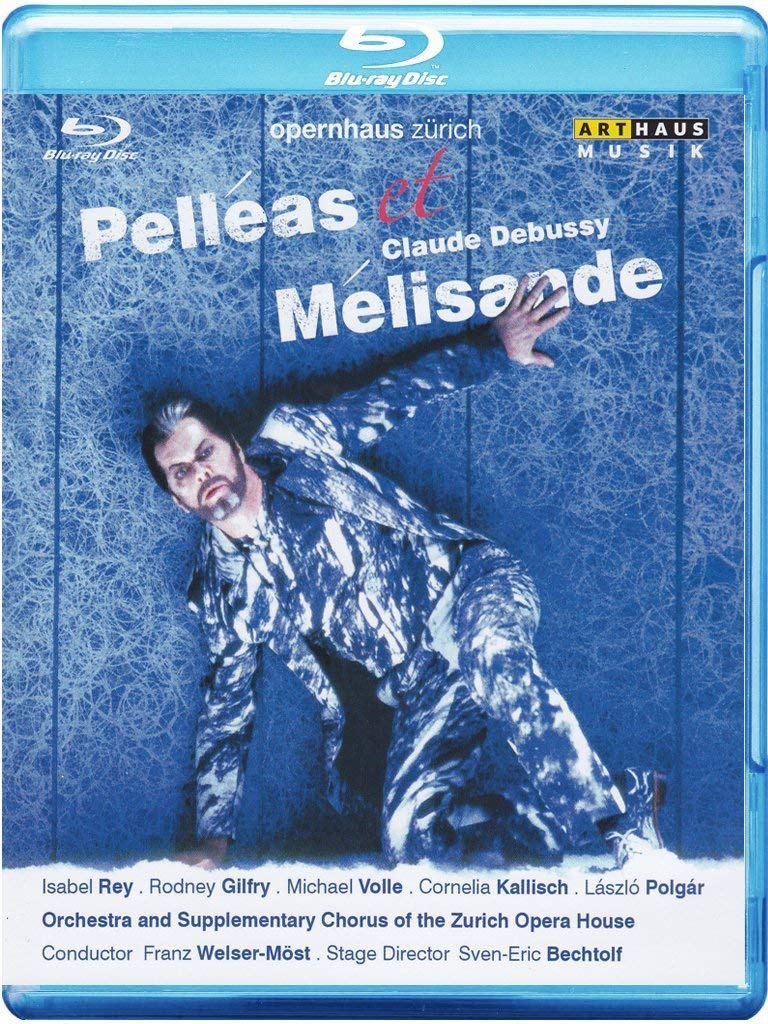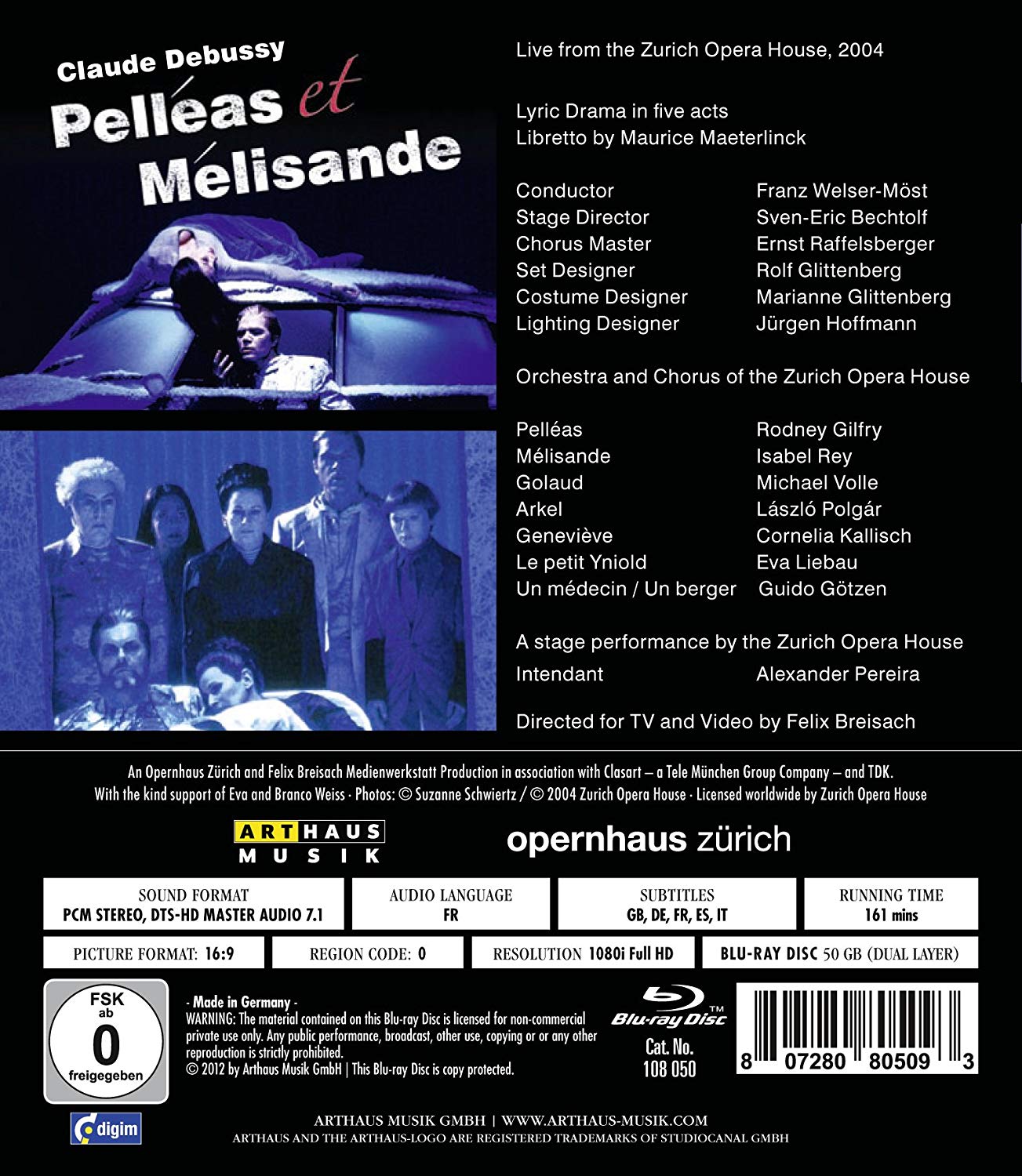

Claude Debussy Pelléas et Mélisande opera to libretto by Maurice Maeterlinck. Directed 2004 by Sven-Eric Bechtolf at Opernhaus Zürich. Stars Rodney Gilfry (Pelléas), Isabel Rey (Mélisande), Michael Volle (Golaud), Lásló Polgár (Arkel), Cornelia Kallisch (Geneviève), Eva Liebau (Le petit Yniold), and Guido Götzen (Doctor/Shepherd). Franz Welser-Möst conducts the Orchestra of the Zurich Opera House and the Chorus of the Zurich Opera House (Chorusmaster Ernst Raffelsberger). Sets by Rolf Glittenberg; costumes by Marianne Glittenburg; lighting by Jürgen Hoffmann. Directed for TV by Felix Breisach. Sung in French. Released 2012, disc has 7.1 dts-HD Master Audio sound. Grade: B
NB: This is a re-release of a title originally published by TDK. Go to our story on the Essener Philharmoniker version of Pelléas et Mélisande for extensive background on the opera and a genealogy of the Arkel royal family.
Pelléas et Mélisande is a made-up-from-scratch Medieval-age fairy tale first presented as a play by the symbolist author Maurice Maeterlinck in 1893. Symbolism was an art movement represented by writers like Poe, Baudelaire, and Mallarmé as well as plastic artists like Leighton, Schwabe, Klimt, Redon, and Munch. As described by Jean Moréas, in symbolism things that happen in the world ". . . will not be described for their own sake . . . they are perceptible surfaces created to represent their affinities with the primordial Ideals." This statement also describes the music of Claude Debussy. So Pelléas et Mélisande became the perfect vehicle for Debussy's landmark modern opera first staged in 1902.
Now fast forward to our Bechtolf/Möst production of 2004 (102 years after the Debussy break-through). The libretto and music are of course the same. But in the design department, the old world of ephemeral symbolism has been jettisoned in favor of a brutal new ice age full of harsh surreal phenomena. So with this production, you will have to deal with both symbolist origins and eclectic modern designs. This will likely be too much to sort out on the fly. For example, the libretto is full of references to forests, lime trees, flowers, parks, birds, sunshine, and warm weather---all of which is utterly inconsistent with the sterile snow-bound sets seen here.
I warned you already that this version takes place in the dead of winter. And each character is represented by a human actor/singer plus a life-sized doll! The actor/singers and the dolls interact in various ways. In the screenshot below, Golaud (Michael Volle) gazes at the Mélisande doll while the actual Mélisande (Isabel Rey) asks the question:
Bechtolf tries to stick to Debussy’s grand design of using interludes between scenes. Felix Breisach gives us some pretty images of the orchestra playing under Franz Welser-Möst:
In the next shot below, King Arkel (Lásló Polgár) discusses his son Golaud, who is still traveling abroad — so it’s appropriate to include the Golaud doll in the scene:
Pelléas (Rodney Gilfry) takes Mélisande (now his sister-in-law) to see the old Fountain of the Blind. The characters facing the audience are humans and those whose backs face the audience are dolls:
Pelléas and Mélisande are already in love although both desperately suppress this. Mélisande loses her wedding ring in the well at the Fountain of the Blind:
At the moment Mélisande loses the ring, her husband Golaud has a frightening accident with his horse. Mélisande ties hard to be a good wife in this scene with two humans and two dolls, but it’s obvious that trouble is ahead:
Here’s an Arkel family portrait with all family members present along with all their dolls. Can you tell from this image which characters are real and which are dummies? I couldn’t do it:
Did you think these characters from the rear were real? BTW: this scene takes place at the mouth of the grotto next to the great ocean. Only Pelléas et Mélisande go to the grotto for this scene. Having 10 extras characters on stage here would be confusing for newcomers and experts alike!
And here’s director Bechtolf’s attempt at the scene with the tower and the long hair. A rotating stage feature helps get this old Citroën onstage:
In the libretto, Pelléas “captures” Mélisande by tying her hair to the branches of the willow tree he has climbed to be near her. Here he captures her by closing the car door on her hair. Is this clever or ridiculous?
The bizarre head below represents Yniold (Golaud’s young son) spying on Pelléas and Mélisande through her bedroom window:
Below Golaud is losing it:
Apropos the last 3 screenshots, I ask: Is Isabel Ray too old and robust to cast as Mélisande? Does she look like a better match for Golaud than for his younger brother?
Let’s sum up. A lot of work went into this production. With the possible exception of the age of Isabel Rey, the singers are fine and the orchestra plays well. PQ and videography are good and the 7.1 dts-HD Master Audio sound recording is excellent. But the cold design and the surreal concepts encountered in this production would make it rather hard for newcomers to enjoy this show and experts might be turned off as well. So I start with the grade of "C+." If Debussy's style of music appeals to you and you promise to chew on this recording a bit, I’ll give this title a B. Shop around and you can probably find it at an attractive bargain price.
OR















